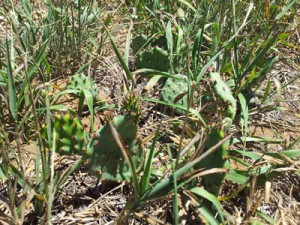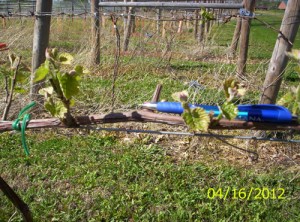Are Mycorrhizae Effective in Midwest Vineyards?
Mycorrhizae refers to a symbiotic relationship between mycorrhizal fungi and the roots of a plant. This fungus and its association with the roots of various types of plants is likely as old as plant life on Earth. Instead of relying on their natural presence in soil, some growers are now inoculating soils with fungus spores in hopes of improving crop performance. However, only recently has information on the benefits of mycorrhizae in Midwestern farms and vineyards started to be gathered.
The mycorrhizal fungus roots, known as hyphae, serve to extend the surface area of the plant roots allowing for the increased uptake of water and minerals. The plant in turn provides the fungus with carbohydrates which are translocated from the leaves to the roots of the plant. The fungus can allow the roots of inoculated plants to contact as much as ten times the amount of soil compared with plants that have low natural fungus amounts or those with no inoculation, according to Dr. Bill Becker of Agrosystems Inc. in Springfield Illinois.
Becker said the mutually beneficial mycorrhizal relationship can provide increased yield for crops such as corn and grape vines which have both been tested with the fungus. He said that inoculation with the spores only needs to be done once. After that, the spores increase every year, he said.
While mycorrhizae are present in soils naturally, some soils that are low in organic matter will have significantly less fungus. Infertile soils can be inoculated with the fungus at the time vines are planted. According to Mike White at Iowa State University, soil conditions that are typically favorable for a plant are also favorable for the fungus, and inoculation may not always be necessary. ‘Plants that are grown in a nursery have a 99.9% chance that the fungus is already on the roots.” He adds that the fungus does better with a higher soil pH.
Becker stated that applying kelp meal has been shown to greatly increase mycorrhizae and is also successful at controlling parasitic nematode populations. According to Becker’s research, controlling nematodes is crucial for the success of mycorrhizae. Nematodes feed on fungi and can reduce or eliminate the chance of a symbiotic relationship forming. Kelp meal treatment research conducted by Becker from 2001 to 2003 revealed a positive correlation with growth of mycorrhizae and appears to be effective controlling nematodes.
Central Illinois Agricultural Farms, Inc. were one of the first to use the kelp meal treatment on a broad scale. From 2004 and 2011, the company’s experience provided evidence that kelp meal treatment is successful in suppressing nematodes.
Perhaps one of the greatest benefits of mycorrhizae is an increase in the uptake of phosphorous. During 2004, Becker began working with an organic farmer who was using mycorrhizae on corn. Becker said that not only did the levels of phosphorous absorbed by the corn go up dramatically after mycorrhizae was introduced, but the inoculation has also eliminated the need for fertilizers. After the one time application, Becker said phosphorous levels continued to go up every year.
According to Becker, the use of fungicides may be counterproductive for mycorrhizae associations. ‘I’m not sure if it’s been proven, but we may be borrowing trouble by using fungicides to fight fungal infections, ” he said. He also stated that organic farmers who do not use fungicides have usually had better luck with the mycorrhizae.
Although the mycorrhizae relationship has been known for many years, the spores did not become commercially available until the mid 1990’s. This lack of availability was primarily due to limited research surrounding the beneficial use of mycorrhizae. In Illinois, naturally occurring mycorrhizae levels were found to be low in row crop fields that were tilled and fertilized, Becker said. According to Becker, after the inoculation of aggressive mycorrhizal fungal species, the amount of mycorrhizal infections significantly increased. He believes that the introduction of the spores likely caused this change in areas that were tested.
In the Midwest, some grape growers are optimistic about increased yields which may be attributable to mycorrhizae applications. Gregg Kane, owner of Illinois River Winery, grows 12 and one half acres of grapes in in Northern Illinois near the town of Peru. Kane said he hired Becker in 2010 because his timber soils, thin and lacking in organic matter, were inhibiting the growth of his grape vines. “Everything seems to grow well now,” Kane said. “However, we did a lot of additional things at the same time as the mycorrhizae. We also adjusted the acidity, iron, zinc, potassium and magnesium in the soil.”
Kane confirmed Becker’s assertion that no negative results have been reported with mycorrhizae in Northern vineyards. To test the effectiveness of the entire soil enhancement program, Kane is doing both ongoing petiole and soil analysis.

Prickly pear cactus grow the sandy soils of Willett’s Central Illinois Vineyard
Brad Beam of Willet’s Winery in Central Illinois, who grows grapes in sandy, acidic soils, said he is willing to give mycorrhizae a try. Beam said that he decided to try mycorrhizae in his vineyard because soil conditions are similar to parts of California and the Mediterranean where the fungus has reportedly worked. “We are one of the few- if not the only- Midwest winery that also has cactus growing in our vineyard,” Beam said.
So this year, Beam dropped about a tablespoon of the fungus in the planting holes for 650 new Vignoles vines. The new plantings are in a low vigor area of the vineyard, Beam said. “We’re going to test mycorrhizae empirically and see if we get results,” he said. Beam went on to add that the first evidence of the effectiveness of the fungus will not be known until spring pruning in 2013.
If mycorrhizae show favorable results, they could play a larger role in the Midwest grape industry. Increased reliance on fungi could reduce the use of nitrogen fertilizer and the runoff of nitrates into groundwater. Yeasts, molds and fungi have been serving man for thousands of years but there is still much to learn.
Credit for Willet’s photo to Doug L. Abbott
[wp_geo_map]



